The Dm6 Guitar Chord, also known as the D minor sixth, adds a unique and sophisticated flavor to your guitar playing. It’s a chord that resonates with a touch of melancholy and richness, making it a favorite in genres like jazz, blues, pop, and even film scores. If you’re looking to expand your chord vocabulary and add depth to your music, understanding and mastering the Dm6 chord is a fantastic step.
This guide will provide you with a comprehensive exploration of the Dm6 chord. We’ll break down the theory behind its construction, show you various positions to play it across the fretboard, and offer tips to help you seamlessly integrate this chord into your musical repertoire. Whether you’re a beginner venturing beyond basic chords or an experienced player seeking to refine your understanding, this tutorial will equip you with the knowledge and tools you need to confidently play the Dm6 guitar chord.
Understanding the Dm6 Chord: Notes and Theory
At its core, the Dm6 chord is built upon four fundamental notes: D, F, A, and B. These notes, when combined, create the characteristic sound of the minor sixth chord. To understand how these notes form the Dm6, let’s delve into the intervals that define it.
The Dm6 chord is constructed using the following intervals:
- 1 (Root): D – This is the foundational note, giving the chord its name.
- ♭3 (Minor Third): F – The minor third interval gives the chord its “minor” quality, lending a touch of sadness or introspection.
- 5 (Perfect Fifth): A – The perfect fifth provides stability and consonance to the chord.
- 6 (Major Sixth): B – This is the defining interval of the minor sixth chord. The major sixth adds a richness and a slightly jazzy, sophisticated quality compared to a standard minor chord.
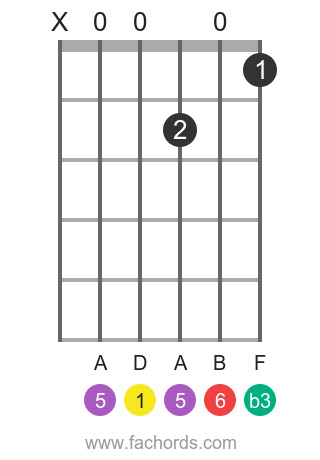 D m6 position 1 guitar chord diagram
D m6 position 1 guitar chord diagram
Image showing the open position 1 Dm6 guitar chord diagram, illustrating a common and accessible way to play this chord.
Understanding these intervals is key not just for the Dm6, but for grasping chord construction in general. If you’re interested in learning more about how chords are built from intervals, our guide on chord construction offers a deeper dive into music theory fundamentals.
Exploring Different Dm6 Chord Positions on the Guitar
One of the beautiful aspects of guitar playing is the ability to play the same chord in multiple positions across the fretboard. This not only provides different voicings and tonal colors but also enhances your fretboard navigation skills. Let’s explore some common and useful positions for playing the Dm6 guitar chord.
Position 1: Open Dm6
This is often the first position guitarists learn for the Dm6 chord due to its accessibility. It utilizes open strings and is relatively easy to finger, making it ideal for beginners.
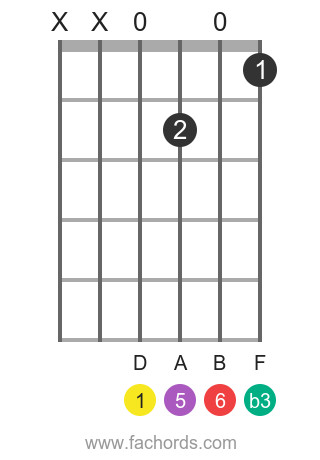 D m6 position 4 guitar chord diagram
D m6 position 4 guitar chord diagram
Diagram illustrating the position 4 Dm6 guitar chord, a movable shape offering an alternative voicing.
Position 2: Movable Shape (Root on 5th String)
This position introduces a movable shape, meaning you can slide this chord shape up and down the neck to play different minor sixth chords. The root of this shape is on the 5th string.
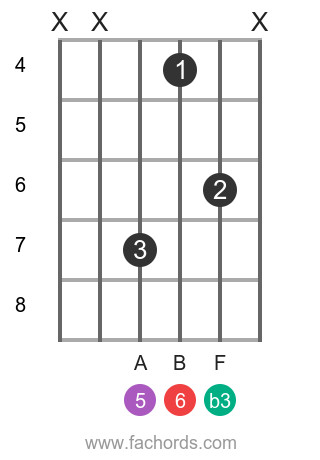 D m6 position 11 guitar chord diagram
D m6 position 11 guitar chord diagram
Chord diagram showing the position 11 Dm6 guitar chord, another movable form with the root potentially on a different string.
Position 3: Open Variation
This is another open position variation of the Dm6 chord. It offers a slightly different voicing compared to Position 1 and can be useful in different musical contexts.
 D m6 position 1 guitar chord diagram
D m6 position 1 guitar chord diagram
Another view of the position 1 Dm6 chord diagram, possibly emphasizing a slight variation or finger placement.
Position 4: Movable Shape (Root on 6th String)
Similar to Position 2, this is another movable shape, but with the root note located on the 6th string. Barre chords knowledge is helpful for this and subsequent positions.
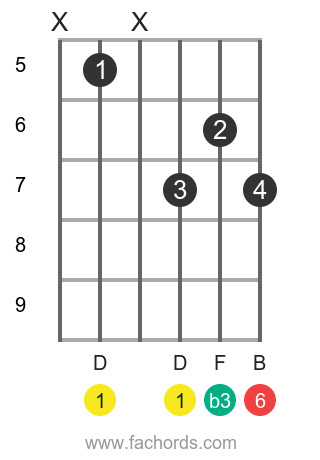 D m6 position 2 guitar chord diagram
D m6 position 2 guitar chord diagram
Diagram of the position 2 Dm6 guitar chord, demonstrating a movable barre chord shape with the root on the 6th string.
Further Positions: Exploring Up the Fretboard
Positions 5 through 11 in the original article offer further variations and movable shapes for the Dm6 chord, often utilizing barre chord techniques. These positions allow you to play the Dm6 chord in various registers and seamlessly transition between different chord voicings as you move up the guitar neck.
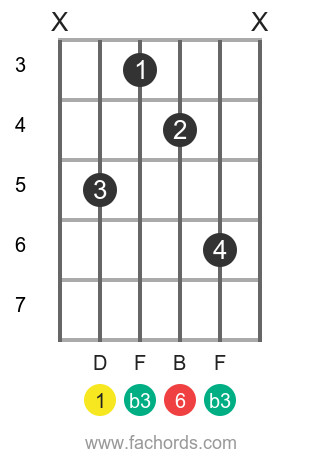 D m6 position 6 guitar chord diagram
D m6 position 6 guitar chord diagram
Position 6 Dm6 guitar chord diagram, showcasing a barre chord shape higher up the fretboard.
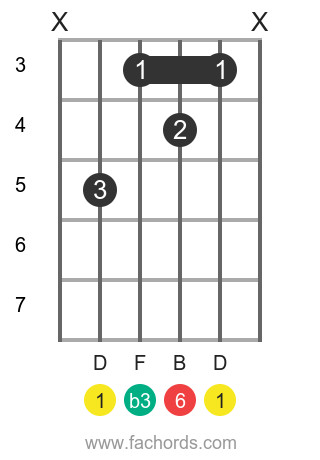 D m6 position 5 guitar chord diagram
D m6 position 5 guitar chord diagram
Chord diagram for position 5 Dm6, another barre chord variation providing a different tonal color.
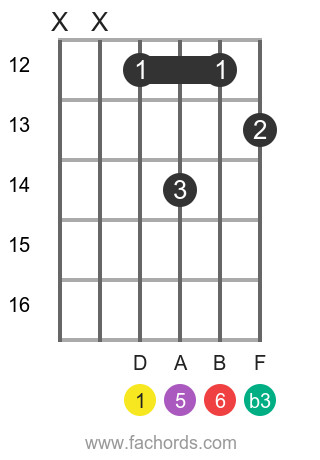 D m6 position 9 guitar chord diagram
D m6 position 9 guitar chord diagram
Position 9 Dm6 guitar chord diagram, likely another barre chord shape offering a unique voicing in a higher register.
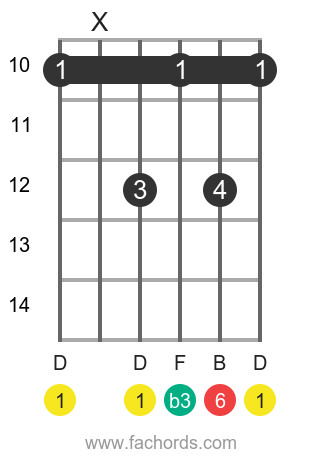 D m6 position 3 guitar chord diagram
D m6 position 3 guitar chord diagram
Diagram of the position 3 Dm6 chord, possibly a partial barre or a variation on a movable shape.
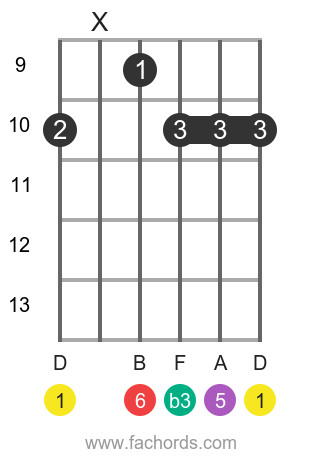 D m6 position 7 guitar chord diagram
D m6 position 7 guitar chord diagram
Position 7 Dm6 guitar chord diagram, illustrating another barre chord form for playing the Dm6 chord.
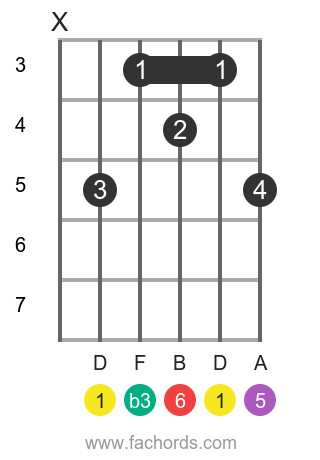 D m6 position 10 guitar chord diagram
D m6 position 10 guitar chord diagram
Chord diagram for position 10 Dm6, continuing to explore barre chord shapes for Dm6 higher on the neck.
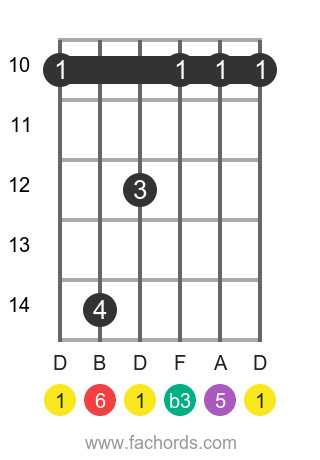 D m6 position 8 guitar chord diagram
D m6 position 8 guitar chord diagram
Position 8 Dm6 guitar chord diagram, potentially the last barre chord variation shown, offering a comprehensive set of shapes.
For guitarists struggling with barre chords, our Bar Chords Tips tutorial offers valuable techniques and exercises to build your barre chord skills.
Incorporating the Dm6 Chord into Your Music
The Dm6 chord is a versatile chord that can be used in a variety of musical contexts. Its distinctive sound makes it a great addition to your chord palette for songwriting, improvising, and playing existing songs.
- Jazz and Blues: The Dm6 chord is a staple in jazz and blues progressions. Its rich, complex sound fits perfectly within the harmonic language of these genres.
- Pop and Soul: Dm6 can add a touch of sophistication and emotional depth to pop and soul songs. It can create interesting chord substitutions and add color to standard progressions.
- Film and Game Scores: The slightly melancholic and evocative nature of the Dm6 chord makes it effective in creating mood and atmosphere in film and video game music.
Experiment with substituting Dm6 for a standard D minor chord in your playing and songwriting to discover the unique flavor it brings.
Conclusion
Mastering the Dm6 guitar chord opens up new sonic possibilities and enhances your understanding of harmony on the guitar. By learning the theory behind its construction and practicing the various positions presented here, you’ll be well-equipped to incorporate this beautiful chord into your musical journey. Explore the different voicings, experiment with its use in various genres, and enjoy the rich and sophisticated sound of the Dm6 chord in your guitar playing.
To further expand your chord knowledge, explore our all guitar chords library for a vast collection of chords and fingerings. And for a handy reference guide, download our Free Guitar Chords Chart Pdf. Happy playing!

